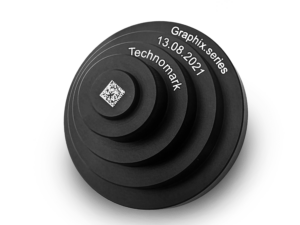Direct Part Marking & Deconstructing Data Matrix Codes

Commerce has come a long way from the bartering system. When currency became the acceptable medium of exchange, it only made sense that a better system of marking products was needed.
The first barcode was created in 1952, but they weren’t put into use in commerce and the transaction process until 1974, when a pack of Wrigley’s gum was scanned in a supermarket in the state of Ohio.
Barcodes have become widely used and have been upgraded and improved in an ongoing process. From the days when a barcode took up a significant amount of the packaging and contained limited information to today’s Data Matrix codes that are significantly smaller and can hold more data, the barcode development process has been fast and focused on efficiency.
Here we will focus on Data Matrix codes, their importance, their history, and an in-depth look at:
- How they’re generated
- How they differ from other marking processes
- What industry these are most common in and on which type of materials and parts are they commonly found
Data Matrix Structure
A 2-D matrix code contains information both horizontally and vertically, allowing more data storage. This also provides built-in error correction and effectively eliminates misreads. This is because the data is typically coded three times within a single data matrix code.
Contrary to the linear layout of a 1-D barcode, Data Matrix codes can be square or rectangular.

The structure of a Data Matrix code includes two solid adjacent borders in an L-shape, with alternating light and dark cells for the remaining two borders. The L-shaped borders are finder patterns, which are the method of setting the correct orientation for decoding.
Clocking patterns include the other two borders and not only define how big the cell is but also determine the size of the code. This indicates the number of rows and columns for decoding.
The quiet zone is the white space around the code, which helps the reader find the barcode. It is recommended that the quiet zone surround the entire code.
Data Matrix codes are also etched directly onto components and can be read by a reader camera or by a mobile phone. These codes can be read from any direction as well – anywhere from 0-360 degrees.
However, keep in mind that conventional barcode scanners won’t be able to read these codes. Instead, it is necessary to have a special kind of scanner, which we discuss in more detail later.
How Data Matrix Differs from Other Code
There are numerous benefits to using a Data Matrix code. The code can include significantly more data while taking up a smaller total area on the product or packaging.
Compared to a barcode, the data matrix code withstands damage more efficiently and increases the odds of readability for the data it holds.
Data Matrix codes provide reliability and accuracy. They are common in the aerospace industry because they are able to provide efficient identification. Data matrix code provides added visibility and reduces the risk of errors and inconsistencies. The use of Data matrix code has become a requirement in many industries for this reason, making it the accepted standard. Data matrix codes that have been damaged with a tear, hole or scratch still provide the entirety of the data contained within, allowing readability to remain optimal.
Data matrix codes can also be read despite being obscured by any type of coating because they can be read at lower contrast ratios than barcodes. These codes also provide flexibility in terms of the imager required to read them, the budget of a project, and processing of products as a result of the marking options and reading performance.
Common Uses for Data Matrix
Efficiency in product tracking, as well as increased attention to safety and liability, have led to the appearance of barcodes on every product. Governments are holding companies more accountable, and today’s technology means there are few excuses that will be accepted if a consumer is injured by a product that isn’t up to spec.
The arrival of a defective product on store shelves can be traced back to the point of origin and products in the same production batch more quickly as a result.
Where do barcodes come in handy?
Barcodes do more than provide a quick price for the consumer. They simplify the management of the supply chain, inventory, and purchasing procedures – in addition to streamlining the process for the consumer at checkout.

There are numerous industries where Data Matrix codes specifically come in handy due to their size and data capabilities. Those include:
- Food Packaging
- Pharmaceutical
- Medical
- Automotive
- Electronics
- Mobile Marketing
- Aerospace Equipment
- Printed Media
Readers Needed for Data Matrix Codes
Laser scanners read 1-D barcodes. These scanners have numerous limitations, including the fact they use oscillating mirrors to operate. These mirrors wear out quickly due to use and also are vulnerable to damage.
Meanwhile, Vision-enabled readers skip the moving parts, which means they are less vulnerable and can be reliable for a longer period of time. Readers are also able to read 1-D and 2-D barcodes at any orientation, which is different than a single-line laser scanner. This makes them the smarter investment when it comes to reading Data Matrix codes.
Consult the Experts
Data matrix codes can be valuable for commerce for many reasons. They can include a significant amount of data and are hard to compromise. For more information on how Data matrix codes can be useful in your business part marking, speak with a Technomark expert today.
For information regarding Laser Marking as a direct part marking method, download our free Laser Marking 101 Guide by filling out the form below:
(Editor’s note: This blog was originally published in October 2022 and was updated in November 2023 to reflect current information.)




